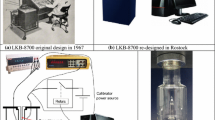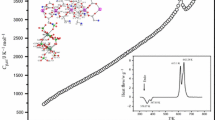Abstract
The heat capacities of four RE isothiocyanate hydrates, Sm(NCS)3, · 6H20, Gd(NCS)3 · 6H20, Yb(NCS)3, · 6H2O and Y(NCS)3, · 6H20, have been measured from 13 to 300 K with a fully-automated adiabatic calorimeter. No obvious thermal anomaly was observed for the above-mentioned compounds in the experimental temperature ranges. The polynomial equations for calculating the heat capacities of the four compounds in the range of 13–300 K were obtained by the least-squares fitting based on the experimentalC P, data. TheC P, values below 13 K were estimated by using the Debye-Einstein heat capacity functions. The standard molar thermodynamic functions were calculated from 0 to 300 K. Gibbs energies of formation were also calculated.
Similar content being viewed by others
References
Tan Zhicheng, Matsuo, T., Suga, H.et al., Low-temperature heat capacities and thermodynamic properties of lanthanum and cerium triisothiocyanate hydrates (I) —La(NCS)3 · 7H20 and Ge(NCS)3 · 7H20.,Science in China, Ser. B, 1992, 35(4): 391.
Tan Zhicheng, Matsuo, T., Suga, H.et al., Low-temperature heat capacities and thermodynamic properties of rare-earth triisothiocyanate hydrates (II) —Pr(NCS)3 · 7H20 and Nd(NCS)3 · 7H20,Science in China, Ser. B, 1996, 39(3): 276.
Kishimoto, K., Suga, H., Seki, S., An on-line automated adiabatic calorimeter in the 13–300 K,Bull Chem Soc. Jpn., 1980, 53: 2748.
Matsuo, T., Suga, H., Adiabadic microcalorimeter for heat capacity measurements at low temperature,Thermochim. Acta, 1985, 88: 149.
Sorai, M., Kaji, K., Kaneko, Y., An automated adiabatic calorimeter for the temperature range from 13 to 530 K,J. Chem. Thermodyn, 1992, 24: 167.
Gruneisen, E.,Handbuck der Physik, 10, Berlin: Julius Springer, 1926, 350–370.
Gopal, E. S. R.,Specific Heats at Low Temperatures, New York: Plenum Press, 1966, 205–226.
{au{fnWagman}, {gnD. D.}}, {atThe NBS tables of chemical thermodynamic properties: Selected values for inorganic and C1 and C2 organic substances in SI units}, {jtJ. Phys. Chem. Reference Data}, {dy1982}, {vn11}({sn2}), supplement.
Yin, J. Z., Jiang, B. G., Sun, T. S.et al., Determination of standard molar enthalpies of formation for rare-earth isothiocyanate Hydrates,Thermwhim. Acta, 1988, 123: 43.
Author information
Authors and Affiliations
Additional information
Project supported by the National Natural Science Foundation of China.
Rights and permissions
About this article
Cite this article
Tan, Z., Matsuo, T., Suga, H. et al. Low-temperature heat capacities and thermodynamic properties of rare-earth triisothiocyanate hydrates (III) —Sm(NCS)3 · 6H2O, Gd(NCS)3 · 6H20, Yb(NCS)3 · 6H20 and Y(NCS)3 · 6H20. Sc. China Ser. B-Chem. 40, 165–176 (1997). https://doi.org/10.1007/BF02876408
Received:
Issue Date:
DOI: https://doi.org/10.1007/BF02876408




